So, Windows 10 is not the Last Windows. And we knew this. Now, to get Windows 11, you need better hardware. Here, we keep all the speculations aside. And see all the methods for TPM Specification details.
Today’s questions are:
- How to check TPM of your computer?
- What is TPM anyway?
- Should you worry if you don’t have TPM 2.0 for Windows 11?
Let’s start these discussions.
Contents
- 1 TPM Version Check via Start Menu Search [ Fastest Method ]
- 2 Use Device Manager To Find TPM Version of your Computer
- 3 Check TPM Version Using Command Prompt / Cmd
- 4 PowerShell Command ‘get-tpm’ and its scope
- 5 Find Your TPM Version using Manufacturer Details
- 6 Concluding This Article about TPM Version Determination
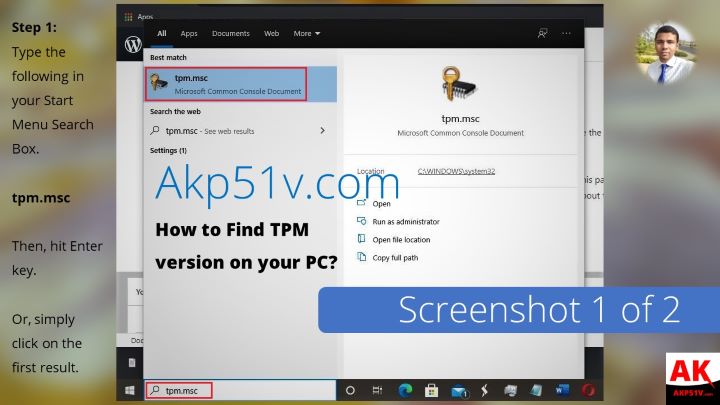
To save your time and to avoid another hassle, type tpm.msc in your Start Menu search box. Congratulations, if you see the window depicted in the next section. That’s it.
No need to waste any time typing any commands. You are welcome.
Look at the row for TPM Manufacturer Information and you are good to go. Also, I have highlighted this part in the screengrab below. Later, you can learn more methods to check your TPM version.
Of course, I have included some notes about this specific requirement in the later sections.
Trusted Platform Module (TPM) Window and its Sections
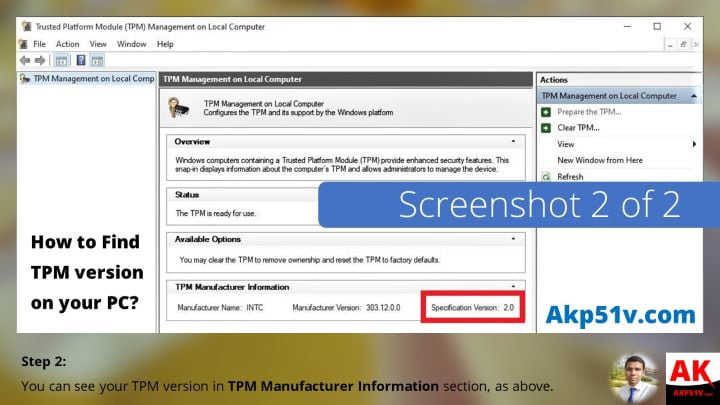
After you study this TPM window, you learn the following details about your TPM.
- In Overview section, you see a simple description for TPM. In short, it is a cybersecurity improvement.
- Then, you can know if TPM is active on your PC. This is a note in Status section.
- The third section, named as Available Options, includes the possible settings for your device TPM. Here, I could reset its ownership and setup as an Administrator.
- Now, the final section is the most important. Because you learn about Manufacturer Name. Thus, you find your computer TPM version in this TPM Manufacturer Information section.
Also, the sidebar on the right includes the options Clear TPM, prepare TPM and Refresh. But you might encounter a problem.
Do you see TPM 1.0 in the About prompt despite of 2.0 Specification?
See, you can click on the Help menu. Then, go to the ‘About TPM Management’ option. And despite the Specification Version showing 2.0, you would see the following screen.

See, this 1.0 version tells you about the ‘TPM Management’ program. Thus, your TPM Specification Version is 2.0 indeed. This is similar to your Anti-Virus Database.
Because updating your Antimalware app is different. And downloading the latest Virus Definitions is another story.
If you find it confusing, you have more options below.
Now, you need to verify our TPM version in a different way. So, how do you determine it in this case? Do not worry. Because it is time to launch your device manager.
Use Device Manager To Find TPM Version of your Computer
Type the phrase, Device Manager, into your Start Menu Search. Then, click on the first result. You will find your Device Manager Window. Hence, click and expand the list item ‘Security Devices’ and get the TPM version.
Yes, the Trusted Platform Module is present in this part. Now, you get the clear and accurate version details.
Without any confusion whatsoever.
See the screen-snip below to locate your TPM version. If it is 2.0 indeed, you meet the Trusted Platform Module requirement. And your PC is almost ready for installing Windows 11.
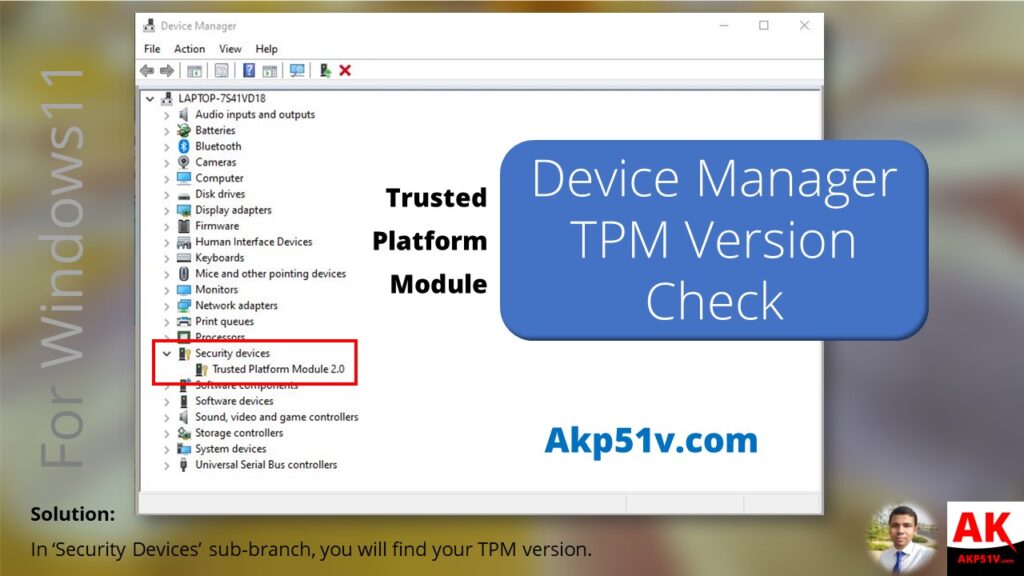
Thus, you know how to confirm your TPM version. Before the notes about this module, I am enlisting more technical methods.
Check TPM Version Using Command Prompt / Cmd
You can launch your Command Prompt using the Start Menu or Run ( Win + R ) box. But in Windows 10, you can use the key-combination of ( Win + X + C ). So, you will start Command Prompt in its normal mode.
To use it in its Administrator mode, use ( Win + X + A ) key-combo.
Here, you must use the ‘Run as Administrator’ mode of Command Prompt. When asked for permission, click the ‘Yes’ button to let Cmd have the admin privileges.
Without the Admin mode, Command Prompt will not show you the details of TPM. In its Normal mode, it shows an Error. And ‘Invalid Namespace’ is its name.
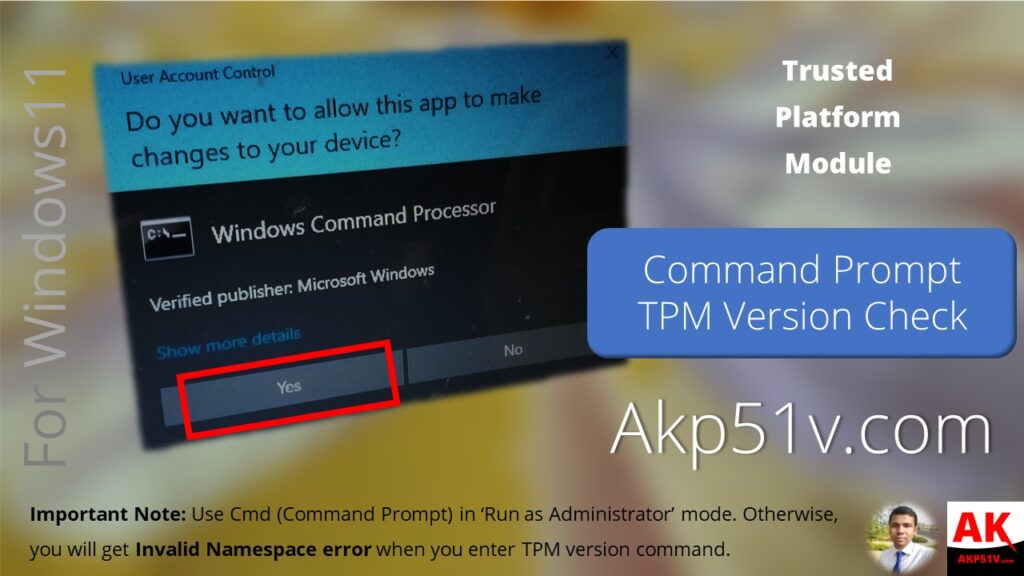
As you understand now, launch Cmd in Administrator Mode.
Cmd Command for TPM version check
Then, type the following command to find the TPM version with Cmd. [ Or, type get-tpm in PowerShell as in the next solution. ] Note that this is a single line. So, press Enter only after typing the final part of .xsl if you are new to Command Prompt.
wmic /namespace:\root\cimv2\security\microsofttpm path win32_tpm get * /format:textvaluelist.xsl
I am repeating the same command in the code box below. Now, you can triple-click this command below. And use (Ctrl + C) to copy-paste this into your computer Cmd (Command Prompt). If unsure, study the upcoming screenshot.
wmic /namespace:\root\cimv2\security\microsofttpm path win32_tpm get * /format:textvaluelist.xsl
And press your Enter key. Hence, I am adding a screenshot below. After this section, you can learn the get-tpm command for PowerShell.
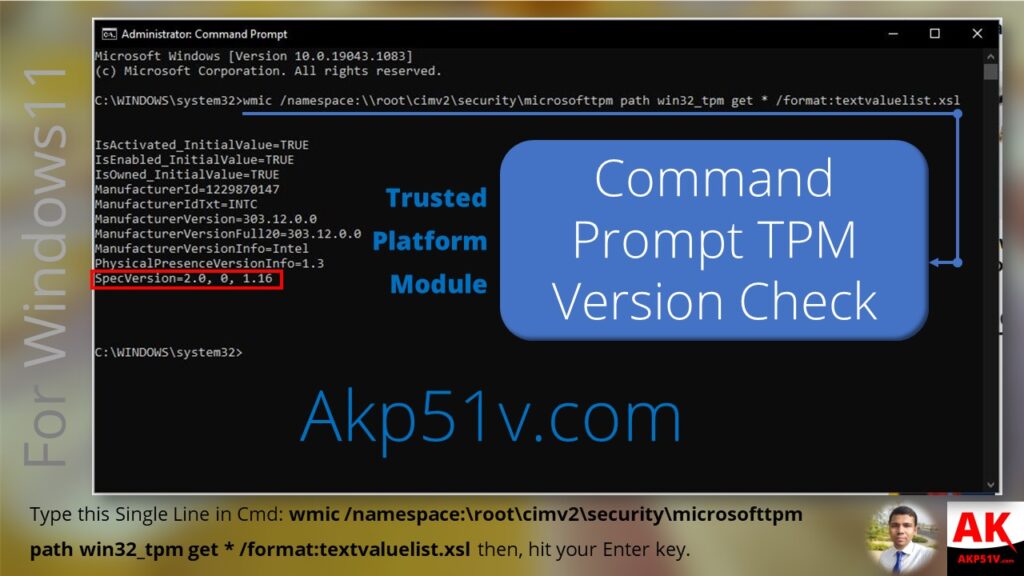
Discussing the Output of Cmd Command for TPM details
For clarity, let me describe each line of the output in brief. (Or, skip to the next section of this post)
The first 3 lines of the output should be true. The full output shows you the following statements.
IsActivated_InitialValue=TRUE
IsEnabled_InitialValue=TRUE
IsOwned_InitialValue=TRUE
ManufacturerId= this will be a series of numbers.
ManufacturerIdTxt= it shows the name of your TPM provider. Here, it reads as INTC. And INTC means Intel. (See the next statements)
ManufacturerVersion and ManufacturerVersionFull20 show you a series like 303.12.0.0 or so.
Again, ManufacturerVersionInfo tells you the name of provider. That is, Intel.
PhyscialPresenceVersionInfo=1.3
Finally, you see SpecVersion=2.0 and other number series. So, you can be sure about it. In short, your computer has version 2.0 of Trusted Platform Module.
(As retrieved in the month of July, 2021 from one of my devices)
With these main methods, I have shared how I have done the TPM specification checks. But if you want to know about TPM availability on your machine, use PowerShell. And this is what you would find below.
PowerShell Command ‘get-tpm’ and its scope
For now, you can launch PowerShell in Admin mode. To do so, type PowerShell in the Start Menu search. Then, click on the Run as Administrator option.
Or, use the Run dialogue box. But use Ctrl+Shift+Enter key combination for Admin or elevated mode. Also, you can start PowerShell in 9 different ways as per an article by HowToGeek site. (Opens in New Tab)
After you start PowerShell (Admin), type get-tpm in it. Such a ‘command’ has another name as cmdlet according to Microsoft. And I have added some reliable resources at the end.
Anyway, after pressing your Enter key, you should see the output.
For instance, let’s discuss the screenshot below.
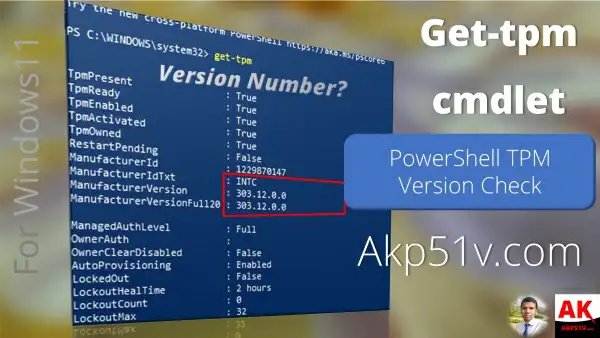
Once you have entered the get-tpm command in the PowerShell user interface, a series of data and values appear. And this experience seems quite similar to that of the CMD. But wait! There is a catch.
You do not see the TPM versions directly.
This is why using the command line seems better. But you will see the Manufacturer Details in PowerShell. And using these details, you can learn about your TPM version over the web.
Let’s learn how to find your TPM version using the Manufacturer Details.
Find Your TPM Version using Manufacturer Details
Note down the following values in your PowerShell Window after you use get-tpm command (or cmdlet). I am using the values in my old laptop.
ManufacturerIdTxt: INTC
ManufacturerVersion: 303.12.0.0
ManufacturerVersionFull20: 303.12.0.0
Then, open your favourite search engine and enter a phrase as shown below.
- tpm ready intc 303.12
- tpm manufacturer intc 303.12
- intc 303.12 tpm version
Replace 303.12 with your Manufacturer Version. And you will find the articles including more details about this. In my case, I found a dozen different sources that confirmed this for me.
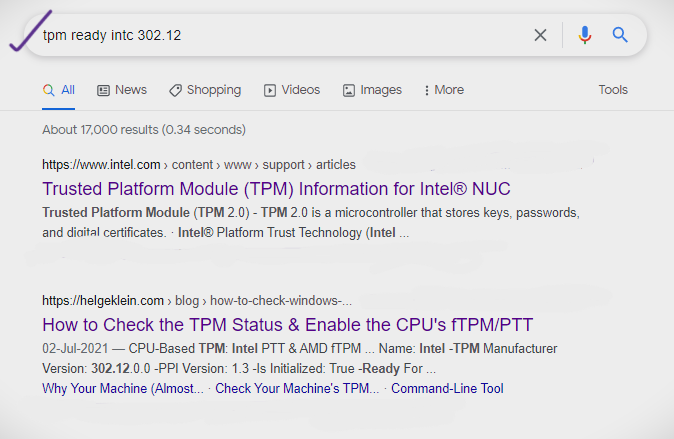
Then, why don’t I recommend the Intel website? I went to that site. And it includes an interesting article about TPM for Intel NUC. But my old laptop did not have those features. So, I became unsure whether to upgrade it to Windows 11 or not.
Thanks to the Command Prompt method, I did not need to waste my time. And now, both of my devices run Windows 11.
Concluding This Article about TPM Version Determination
You have learnt about the safe or easier methods of identifying the version of the Trusted Platform Module. So, all the best with this investigation of your PC. Do you need to worry about this? Not necessarily. Because TPM 2.0 came out near the end of the year 2014.
As such, most modern computers are destined to have TPM available.
Even if you do not have TPM 2.0, some online sources claim to know the technical workarounds. But I do not think that such solutions can work in the long term. Those are not for everyone.
By the way, if you still desire to find your TPM version with PowerShell alone, you can find that article in screenshot 7 quite educational. But you need a lot of experience of working with PowerShell to carry their instructions without fail.